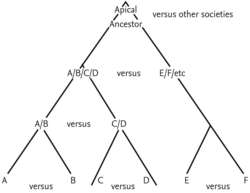segmentary societies


Fig. 27 Segmentary societies. At each level, membership of a descent group (A; A/B; A/B/C/D; etc.) defines the basis of allegiance and mutual support(e.g. in feuds).
segmentary societies
forms of STATELESS SOCIETY, whose fundamental mode of social organization is a lineage system in which descent group membership is defined in terms of, sometimes notional, common ancestors (apical ancestor). Such systems, involve a hierarchical structure, which at each level defines expected bases of membership and opposition (see Fig. 27). A classical account of such a system is EVANS-PRITCHARD's (1940) account of the Nuer. However, this account, and the concept of segmentary society in general, has been criticized as presenting only an ‘ideal’ model of social relationships in such societies. see also SEGMENTARY STATES.Collins Dictionary of Sociology, 3rd ed. © HarperCollins Publishers 2000
References in periodicals archive
(8) Hudson's classification seems to agree with that of Robin Horton, who in his study of
segmentary societies established dispersed and nucleated settlements as the patterns among
segmentary societies.
This sort of organization helps to "affirm the rights of
segmentary societies in opposition to the organs of State power." (p.
Generally, there are two types of indigenous leadership systems among
segmentary societies in the South Pacific: clan leadership in Melanesia and chief leadership in Polynesia (Strathern & Godelier, 1991).
Copyright © 2003-2025 Farlex, Inc
Disclaimer
All content on this website, including dictionary, thesaurus, literature, geography, and other reference data is for informational purposes only. This information should not be considered complete, up to date, and is not intended to be used in place of a visit, consultation, or advice of a legal, medical, or any other professional.
